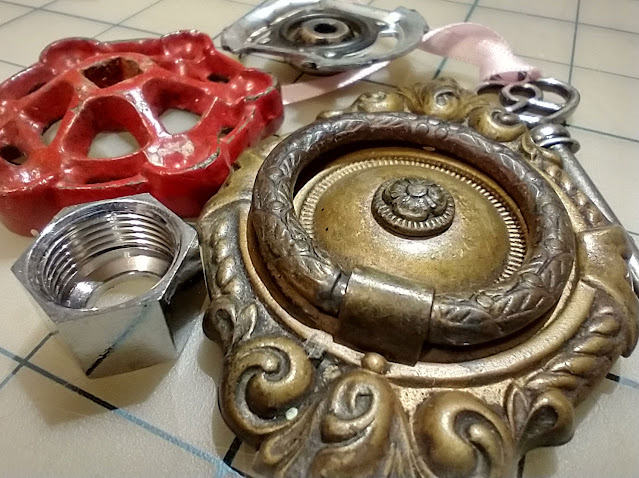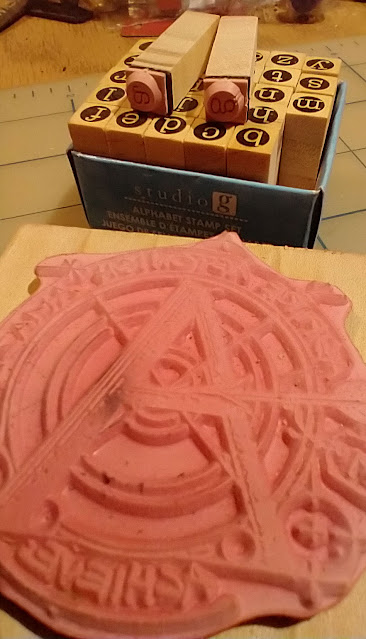Our craft club just started working with leather. A handful of us are making our very first leather wallets and tool holders. Even though we have no idea what we are really doing, we started happily crafting away.
When the other members saw us, they were inspired to also try their hand at leather work. They weren't ready to cut and punch and stitch. But stamping their initials onto blank coasters appealed to them. Luckily when we made our initial leather purchase, we included a pack of coaster blanks for just such an event.
However, we hadn't purchased any stamping or carving tools. We thought our basic collection of bevelers and punches would be all the tools we needed for at least a few months. Although stamps and carving tools are not very expensive, we had just made a large purchase, and nobody wanted to spend more money right away.
We'll likely purchase a set or two of "real" leather stamps (affiliate) in the future, but until then, we are having lots of fun finding alternative ways to make impressions on leather. A few of us had played with leather enough to know that you can make a mark or stamp it with objects we already had around the studio. The other members thought we were crazy, thought that you had to have the exact leather-specific tool in order to get good results. But us old timers gathered some items and proved to them that you can get good results using tools intended for other uses.
Everybody was happily surprised with the good quality of the results. But the combination of initial disbelief and eventual embracing of these alternative tools convinced us a blogpost was warranted.
THINGS WE ALREADY HAVE
We already owned a huge selection of cutters and stamps for both clay and polymer clay. They aren't as detailed as the leather stamps, but we liked some of the designs. We weren't sure if all the plastic versions would be strong enough, or if the metal versions would cut the surface of the leather, so we went slow.
We don't have an arbor press, so we just used clamps and a vise. We could apply pressure gradually to test the results and durability. And our tightest clamping is far less than the multi-ton pressure you get from a real press.
We found that the thick plastic and wood versions worked well. Some of the metal ones, especially the actual cookie cutters, could scar the leather. But we could avoid the damage if we applied a light pressure at first, then let the leather conform to the shape before applying more pressure. You can repeat the process to safely get deeper impressions.
The following examples are not the exact objects that we own but are similar to them. You can get a good idea of the types of things that will work. If you only want to stamp leather, we do recommend purchasing real leather stamps instead these plastic versions. But if you want to have a cheap, versatile collection of shapes that you can use on multiple materials, these are good enough to start with and will keep the kids and beginners happy for their first few projects.
Cookie Cutters and Clay Stamps
Western Themed (affiliate) They're simple and maybe a little too big, but they make a great starting point. Includes a horned steer head, a cactus and other traditional western themed shapes. They are thin enough to fit inside the vise jaws, and the plastic is tough enough to withstand the pressure. You can get Asian or Celtic, airplanes or dinosaurs, sports or construction equipment. If you have a theme, someone has probably made a clay cutter to fit it.
Wood Pottery Stamps (affiliate) 18pc detachable. These are wooden disks with a variety of designs including hearts, flowers, shamrock, basic geometric shapes and even a peace sign. They are meant to go on the end of the included handle, but since they are flat, they can easily be put in a press.
Wooden Heart and Flower Stamp (affiliate) These are on a shaft, so you can't use them in a press very easily. You can whack them with a mallet and get a decent impression, but they probably won't last long when used that way. We wouldn't suggest buying these for leatherwork, but if you already have them, they do work. Just be gentle with them.
Simple Outlines (affiliate) These are great for framing a stamped name, at the end of belts and flaps, or adding visual interest to any empty space. You can also overlap them to create more complex shapes, but it requires multiple pressings.
Letters and Numbers (affiliate) You can get all kinds of fonts, from simple sans serif to ornate curls and from graffiti to gothic. They are big enough to read easily when impressed into leather. Most are not designed to "gang print," so you'll have to press each letter individually. That's fine for initials or short words, but a real pain for longer phrases. If you want to print phrases, it's probably better to get a system that lets you put several characters together (affiliate) and make a single impression.
Embossing Plates (affiliate) Some of those flat-plate embossing systems, designed for paper and scrapbooking. work fine on leather. We had access to some plates, but not the machine. Some of us had used the machines in the past, so we knew that some of the embossing machines can accommodate thin leather, (affiliate) or even cut through it for die cutting. But a thick 8-9oz leather might be more than most can handle. It would be better to get a machine made specifically for leather if you want to do thick leather or punch out a bunch of blanks quickly and reliably.
Stamps for Metal
We have a collection of letter and number stamps meant to be used on metal (affiliate). We knew they would be strong enough, but most of the fonts we own are small. We wondered if the lettering would be legible. Most of the simpler, sans serif fonts work fine. The fancy, quirky or script fonts still work, but aren't quite as easy to read. The stamps with a long bevel around the letters work much better than the ones where the letters barely extend above the body of the shaft.
Our metal stamps were usually 1-3mm, which is typical for metal stamps. But most letter stamps for leatherwork are much larger, (affiliate) more in the 4-8mm range, even up to 1/2" (13mm). A lot of the leather stamps have a more decorative feel, or even have outlines or a 3d effect. They read much better from a distance.
Buttons and DooDads
You can find giant buttons, knobs and handles that have Celtic knots, (affiliate) anchors, flowers and the faces of Greek gods incised deeply on their surfaces. Some of them are deep enough that you use them to make impressions on leather.
Monogram cufflinks, Fleur-de-Lys tie-tacks, and heart shaped broaches all work well. You may need to trim off the back-posts first or embed them in some type of backer. If they were so cheap that the faux metal finish has worn off, that's even better. It's a second useful life for them.
Pieces of ornate wood trim and sheets of perforated metallic grates work nicely. The ends of ornate silverware, brand emblems, or even scavenged mechanical bits all make good stamps. Gears, plumbing fixtures and parts of old appliances all make good shapes.
Just look around; your house and studio are filled with great mark-making items.
What Did Not Work
Rubber inking stamps, even the deeply cut ones, did not work well. We did wonder if we could use leather dye instead of ink and get some interesting effects. Someday, when we're a little braver, and have a lot of scrap leather, we may try that.
We also did not have good luck with texture rollers. It kind of worked, but the results were unpredictable and the rollers were hard to control. But we think if we added a jig to keep higher pressure when the leather is rolled (like a pasta machine) they might work better. We've seen rollers used to emboss business cards using that technique, so it's probably worth investigating.
3D Printing, CNC and Laser Cutter
This is something I'm particularly interested in trying. From a quick look on YouTube, it seems like you can make almost any shaped stamp with these tools. I hope we do enough to generate at least one blogpost dedicated to this technique.
CRICUT and Craft Cutters
Modern craft-cutters like the CRICUT Maker 3 can easily cut and emboss leather. (affiliate) We own an older craft-cutter but have only cut paper and vinyl, so we don't own the embossing tools designed for leather. But now that we own sheets of leather and are more comfortable working with it, we will certainly buy the blades and embossing tools we need. (affiliate) We will definitely post our results when we do. I think more of our members are excited about using leather on the Cricut than the more traditional leathercrafts.
Figuring out which tool works in which machine for which material can be confusing for beginners. We already made and published a helpful list of the tools and what they do, so we already know which tools we want and which will work with our model of machine.
SUMMARY
Leather is a forgiving material. It takes a good impression from a wide variety of tools and objects. Don't be timid, don't wait until you have a collection of specialty tools; just find some attractive shapes and start pressing them into a piece of wet leather. You will be pleased with the results.




Good
ReplyDeleteGood
ReplyDeleteGood
ReplyDeleteGood
ReplyDeleteGood
ReplyDelete